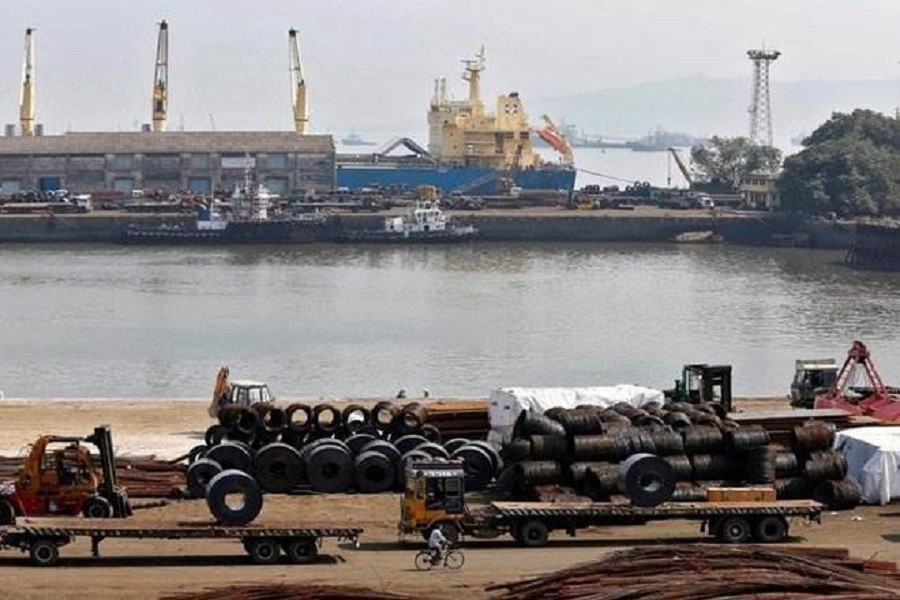A move is underway to make India's Haldia as "transshipment port" for Bangladesh's export-import trade as an alternative arrangement to leapfrog shipping congestion, amid some reservations, though.
Sources said the plan is "not convincing yet" to many an insider for this transshipment would involve higher transport time and cost.
The sceptics also view that there are some "technical clauses over third-country cargo handling by Indian ports" which still remained pending although the Indian Customs recently relaxed their bilateral contract with Bangladesh about cargo handling by Haldia Port only over 170 nautical miles from Mongla port of Bangladesh.
A number of exporters from Bangladesh, Pangaon Port Authority here, and Haldia Port authority of India are apparently have been engaged in sorting out the issue for their respective interests, people familiar with the matter told the FE.
The planned route is Pangaon-Haldia-Colombo which takes around three days' extra time over Chittagong-Colombo route, they said.
Currently, Haldia Port operated by private parties remained like "desert" for lack of cargoes although it is equipped with modern container-handling facilities.
Transshipment is shipment of goods or containers to an intermediate destination and then to yet another destination - -here it is Colombo.
But using this transshipment will involve at least US$ 200 in additional cost for each 40-foot box, in addition to extra time consumption, according to a paper presented at a recent seminar.
In the meantime, a regional seminar will take place in Kolkata on February 27 which six Bangladeshi participants may join. The subject of the seminar is 'Resurgent Bengal: Vibrant Hinterland in Smart Logistics Summit & Awards'.
Those who are going to attend the seminar told the FE that the issue of the use of Haldia port for Bangladeshi cargoes meant for Europe and other destinations will be highlighted in discussions.
They said the move is just to find an alternative to the Chittagong port which has been over-congested in recent times mainly due to rise in containers coupled with lack of adequate handling equipment.
It has a big gantry crane accident more than six months back and but was yet to be replaced, leading to the weakening of the ports operational capacity significantly.
Shipping experts working with different international shipping firms in Bangladesh told the FE that the transportation time and cost would be higher if the Haldia is introduced as alternative to the Port of Chittagong.
They said around three days extra will be needed to reach Colombo port, a hub of large ships plying between the capital of Sri Lanka (Colombo) and different ports of Europe as well as other international ports.
"Actually Chittagong port has became congested and its productivity waned for lack of gantry cranes. For this reason, many are opting for alternatives to Chittagong port," said Captain AS Chowdhury, the country head of one of the leading feeder-service providers -- Seacon.
"In my view this is not a long-term solution as it will require much time and cost which impact on the export products," he told the FE.
A senior executive at MCC, a strategic business unit of world's largest shipping company -- Maersk Line -- said: "We're yet to be convinced over the proposed route as it needs to solve many pending issues, especially pertaining to handling third-country cargoes by the Indian port."
He commented about the prospect: "It seems to me a bleak one and not so promising."
He also said there will be big challenges facing the shipping lines in ensuring adequate containers to make the route viable.
"I am really sceptical over adequate number of containers for the route as the Pangaon now handles per month 40 to 50 boxes of imports from India through the route or through Kolkata port," the shipping executive told the FE.
Under an existing protocol between Bangladesh and India vessels carry both exports and imports between the two neighbouring countries. They usually carry some industrial raw materials for Bangladesh's cement factories.
On the other hand, Dhaka Chamber of Commerce and Industry (DCCI), which had organised a seminar on the same issue just few days back in Dhaka, said they are yet to study in detail the feasibility of the transshipment arrangement.
People at the DCCI said they actually are "brainstorming" on the possible alternatives to the Chittagong port which handles around 90 per cent of Bangladesh's external trade.
They said Chittagong port has some big plans to expand its capacity but it will take some more time and the trade will suffer if there be no alternative in the meantime.
Abul Kashem Khan, president of the DCCI, said: "We're yet to conduct detailed study as to whether it is feasible or not for Bangladeshi exporters and importers, but this is just a brainstorming on possible alternatives.
"Chittagong Port will need time to build its planned projects, so we actually need alternatives," the chamber leader told the FE.
He said there was no pressure group like exporters for exploring such alternatives. "As a trade- promotion organisation we just organised that seminar at our own initiative."
If the route is introduced as an alternative, Chittagong port will again incur revenue losses, people at the Chittagong Port Authority told the FE.
In response, the DCCI chief said actually there will be some revenue losses for Bangladesh's biggest port, but, in the long run, Chittagong port will gain as its efficiency and capacity will expand manifold to handle much cargo.
Ahmed Karim Chowdhury, terminal manager at the Pangaon Inland Container Terminal, a concern of the Chittagong Port, said his terminal remain vacant most of the time of the year for lack of cargoes and has been facing challenges in making it fully utilised for long.
Mr Chowdhury, who will also join the seminar in Kolkata, is hopeful about getting substantial containers if the Haldia is introduced as transshipment port. There are many issues still remaining to be settled to use the Indian port, he told the FE correspondent.


